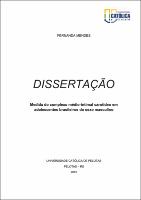| Compartilhamento |


|
Use este identificador para citar ou linkar para este item:
http://tede.ucpel.edu.br:8080/jspui/handle/tede/156| Tipo do documento: | Dissertação |
| Título: | Medida do complexo médio-intimal carotídeo em adolescentes brasileiros do sexo masculino |
| Título(s) alternativo(s): | CAROTID INTIMA-MEDIA THICKNESS IN MALE ADOLESCENTS |
| Autor: | Mendes, Fernanda  |
| Primeiro orientador: | Barros, Fernando Celso Lopes Fernandes de |
| Primeiro membro da banca: | Horta, Bernardo Lessa |
| Segundo membro da banca: | Gonzalez, Maria Cristina |
| Resumo: | OBJECTIVES: Assess the carotid intima-media thickness (IMT) in a sample of male adolescents in a southern Brazil city, and investigate the association of this measure with biological and demographics variables. METHODS: Cross-sectional study in a random sample of 239 eighteen years old male adolescents, in the Pelotas city military recruitment, in the south of Brazil, held in July 2010. The presence of cardiovascular risk factors was investigated by a questionnaire and physical examination (weight, height, blood pressure and waist circumference). The study was performed in B-mode ultrasound of both common carotid arteries, with IMT measurement in the posterior wall, at a distance of 1.0 to 2.0 cm of the carotid bifurcation. We obtained five measurements of each common carotid and the mean of both sides corresponded to the carotid IMT of each participant. RESULTS: The mean carotid IMT was 0.4969 (± 0.0466) mm and atheromatous plaque were not identified in any adolescent. In the multivariate analysis, BMI (p=0.005) and waist circumference (p<0.001) were positively associated with carotid IMT. CONCLUSION: The association of BMI and waist circumference with the carotid IMT during adolescence shows the importance of adiposity as a cardiovascular risk factor |
| Abstract: | OBJECTIVES: Assess the carotid intima-media thickness (IMT) in a sample of male adolescents in a southern Brazil city, and investigate the association of this measure with biological and demographics variables. METHODS: Cross-sectional study in a random sample of 239 eighteen years old male adolescents, in the Pelotas city military recruitment, in the south of Brazil, held in July 2010. The presence of cardiovascular risk factors was investigated by a questionnaire and physical examination (weight, height, blood pressure and waist circumference). The study was performed in B-mode ultrasound of both common carotid arteries, with IMT measurement in the posterior wall, at a distance of 1.0 to 2.0 cm of the carotid bifurcation. We obtained five measurements of each common carotid and the mean of both sides corresponded to the carotid IMT of each participant. RESULTS: The mean carotid IMT was 0.4969 (± 0.0466) mm and atheromatous plaque were not identified in any adolescent. In the multivariate analysis, BMI (p=0.005) and waist circumference (p<0.001) were positively associated with carotid IMT. CONCLUSION: The association of BMI and waist circumference with the carotid IMT during adolescence shows the importance of adiposity as a cardiovascular risk factor |
| Palavras-chave: | medida do complexo medio-intimal arteria carotida aterosclerose adolescentes ultrason Intima-media thickness, Carotid artery, Atherosclerosis, Adolescents, Ultrasound |
| Área(s) do CNPq: | CNPQ::CIENCIAS DA SAUDE::MEDICINA |
| Idioma: | por |
| País: | BR |
| Instituição: | Universidade Catolica de Pelotas |
| Sigla da instituição: | Ucpel |
| Departamento: | saúde |
| Programa: | Mestrado em Saúde e Comportamento |
| Citação: | MENDES, Fernanda. CAROTID INTIMA-MEDIA THICKNESS IN MALE ADOLESCENTS. 2010. 84 f. Dissertação (Mestrado em saúde) - Universidade Catolica de Pelotas, Pelotas, 2010. |
| Tipo de acesso: | Acesso Aberto |
| URI: | http://tede.ucpel.edu.br:8080/jspui/handle/tede/156 |
| Data de defesa: | 9-Dez-2010 |
| Aparece nas coleções: | Biblioteca Digital de Teses e Dissertações |
Arquivos associados a este item:
| Arquivo | Descrição | Tamanho | Formato | |
|---|---|---|---|---|
| MESTRADO FERNANDA.pdf | 491,01 kB | Adobe PDF |  Baixar/Abrir Pré-Visualizar |
Os itens no repositório estão protegidos por copyright, com todos os direitos reservados, salvo quando é indicado o contrário.




